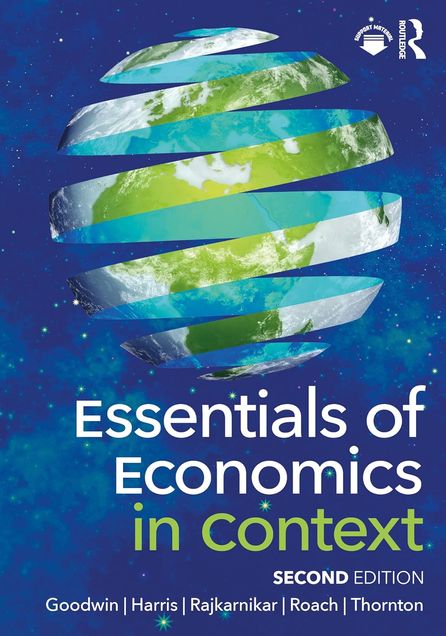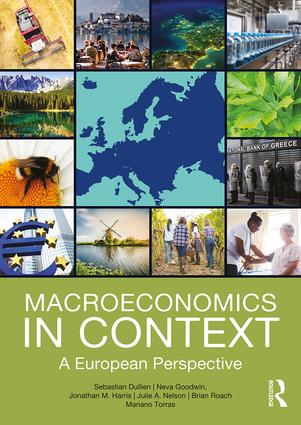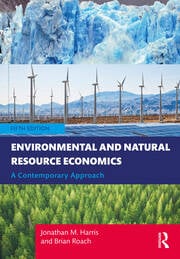Textbooks
Textbooks page
Economics Textbooks
The Economics in Context Initiative develops textbooks for use in teaching introductory and environmental economics in the United States and abroad.
Microeconomics in Context
 Microeconomics in Context lays out the principles of microeconomics in a manner that is thorough, up to date, and relevant to students. Like its counterpart, Macroeconomics in Context, the book is uniquely attuned to economic, social, and environmental realities. The “in Context” books offer affordability, accessible presentation, and engaging coverage of current policy issues from economic inequality and global climate change to taxes and globalization.
Microeconomics in Context lays out the principles of microeconomics in a manner that is thorough, up to date, and relevant to students. Like its counterpart, Macroeconomics in Context, the book is uniquely attuned to economic, social, and environmental realities. The “in Context” books offer affordability, accessible presentation, and engaging coverage of current policy issues from economic inequality and global climate change to taxes and globalization.
More details and ordering information
See related supplemental materials
Macroeconomics in Context
 Macroeconomics in Context is the companion text to Microeconomics in Context. While covering standard topics such as classical and Keynesian approaches, the text addresses issues of ecological sustainability, non-marketed production, quality of life, and income distribution. The text focuses on policies that achieve macroeconomic stabilization while promoting long-term sustainability and human well-being.
Macroeconomics in Context is the companion text to Microeconomics in Context. While covering standard topics such as classical and Keynesian approaches, the text addresses issues of ecological sustainability, non-marketed production, quality of life, and income distribution. The text focuses on policies that achieve macroeconomic stabilization while promoting long-term sustainability and human well-being.
More details and ordering information
See related supplemental materials
Principles of Economics in Context
 Principles of Economics in Context combines the Microeconomics in Context and Macroeconomics in Context books to offer a full presentation of economic issues in real world context, including economic, environmental, behavioral, and social issues.The text is available in print and as an eBook.
Principles of Economics in Context combines the Microeconomics in Context and Macroeconomics in Context books to offer a full presentation of economic issues in real world context, including economic, environmental, behavioral, and social issues.The text is available in print and as an eBook.
More details and ordering information
See related supplemental materials
Essentials of Economics in Context
Essentials of Economics in Context is a  one-semester introductory economics text, combining the foundations of microeconomic and macroeconomic theory. It includes ample real-world examples covering topics such as environmental sustainability, financial stability, globalization, inequality, and human well-being. With updated research and policy discussions, the second edition offers a fresh understanding of key economic problems of the twenty-first century.
one-semester introductory economics text, combining the foundations of microeconomic and macroeconomic theory. It includes ample real-world examples covering topics such as environmental sustainability, financial stability, globalization, inequality, and human well-being. With updated research and policy discussions, the second edition offers a fresh understanding of key economic problems of the twenty-first century.
More details and ordering information
See related supplemental materials.
Macroeconomics in Context: A European Perspective
 Macroeconomics in Context: A European Perspective is latest addition to the bestselling “In Context” series of textbooks. Written with a specific focus on European data, institutions and historical events, it offers engaging treatment of high-interest topics, including sustainability, Brexit, the euro crisis and rising inequality. Policy issues are presented in context (historical, institutional, social, political and ethical), and always with reference to human well-being.
Macroeconomics in Context: A European Perspective is latest addition to the bestselling “In Context” series of textbooks. Written with a specific focus on European data, institutions and historical events, it offers engaging treatment of high-interest topics, including sustainability, Brexit, the euro crisis and rising inequality. Policy issues are presented in context (historical, institutional, social, political and ethical), and always with reference to human well-being.
More details and ordering information
See related supplemental materials
Environmental and Natural Resource Economics: A Contemporary Approach
 Environmental and Natural Resource Economics: A Contemporary Approach, by Dr. Jonathan M. Harris and Dr. Brian Roach, presents in-depth analysis of major topics in resource and environmental economics. The fifth edition deals with the fast-changing economics of energy and climate, the rapid expansion of renewable energy, and issues of land management, as well as updating all data and presenting recent research on environmental issues.
Environmental and Natural Resource Economics: A Contemporary Approach, by Dr. Jonathan M. Harris and Dr. Brian Roach, presents in-depth analysis of major topics in resource and environmental economics. The fifth edition deals with the fast-changing economics of energy and climate, the rapid expansion of renewable energy, and issues of land management, as well as updating all data and presenting recent research on environmental issues.
More details and ordering information
See related supplemental updates on environmental economics issues
See related supplemental updates on contemporary economic issues
Top of Page
by Neva Goodwin, Jonathan Harris, Pratistha Joshi Rajkarnikar,
Brian Roach, and Tim Thornton
Essentials of Economics in Context is specifically designed to meet the requirements of a one-semester introductory economics course that provides coverage of both microeconomic and macroeconomic foundations. Theoretical expositions in the text are kept close to reality by integrating numerous real-world examples and by presenting the material in an accessible and engaging style. The second edition has been updated to incorporate up-to-date research on topics such as behavioral economics, economic inequality, macroeconomic policy, labor economics, national accounting and environmental challenges. This new edition also places a greater emphasis on global issues, making it an excellent resource for an introductory economics course globally.
The Second Edition is now available for pre-ordering.
Pre-Order the Second Edition via Routledge.
Order Hardback: $168.00 Paperback: $63.99

Instructors
For a free exam copy, please contact Routledge.
To access instructor only teaching materials, including test banks, contact us. Please indicate what course you teach and provide proof of your instructor status (e.g. a link to your bio, or the course website).
You may also utilize Canvas, a learning management system, for automatic grading online; for more information about Canvas, read our user’s guide and contact us to request access to our demonstration sites. Please specify if you are teaching the First of the Second edition and indicate where and what course you teach.
Student Supplements
Access student study guide, PowerPoint slides, and online appendices for the Second Edition and First Edition.
Preview the Second Edition
The Second edition has been extensively revised in response to recent developments. Hundreds of new references have been added to include the most recent research and policy debates. Also, several boxes that are no longer timely have been deleted and new boxes have been added. A special feature of this edition is an expanded discussion on topics outside the United States to highlight major international issues. A brief summary explains key features of the Second edition.
Preview the Book
Access the Table of Contents
Chapter 2: Foundations of Economic Analysis
- Updated discussion on the three spheres of economic activity.
- Updated data on the relative size of the different spheres of the economy, including the informal sphere in lower-income countries
- More streamlined discussion of the different types of markets Chapter 4: Consumption and Decision-Making
- Discussion of the most-recent research on behavioral economics, including
neuroeconomics, the ultimatum game, and social trust - Updated discussion on the social and environmental contexts of consumption, and public
policies on consumption
Chapter 4: Consumption and Decision-Making
- Discussion of the most-recent research on behavioral economics, including neuroeconomics, the ultimatum game, and social trust
- Updated discussion on the social and environmental contexts of consumption, and public policies on consumption
Chapter 14: Economic Inequality
- New chapter focused entirely on economic inequality
- Extensively updated data on national and global inequality
- Updated discussion of inequality in lower-income countries
Chapter 16: Economics of the Environment
- Updated material on global climate change data and policies, including discussion of
commitments by major countries to reduce emissions - Discussion of growth limits and steady state economy
- Focus on “green” macroeconomic policy
Key features of Essentials of Economics in Context include:
- an inclusive approach to economics, where the economy is analyzed within its social and environmental context
- an innovative chapter examining data on various economic indicators
- focus on goals of human well-being, stability, and sustainability, and inclusion of core and public purpose spheres, instead of solely focusing on market activities
- a wealth of online materials such as slides, test banks, and answers to exercises in the book
| Praise for Essentials Economics in Context “Essentials of Economics in Context is a remarkable text for a one-semester principles course. It is one of the few books that not only provides a thorough explanation of neoclassical micro- and macroeconomics, but also presents dissenting theories and viewpoints in ways that encourage students to think critically about how economists can help improve economic and social wellbeing.” |
Essentials of Economics in Context, First Edition
by Neva Goodwin, Jonathan Harris, Julie Nelson, Pratistha Joshi Rajkarnikar, Brian Roach, & Tim Thornton
Preview the Table of Contents and sample chapters:
Access the Table of Contents
Chapter 2: Foundations of Economic Analysis
Chapter 4: Consumption and Decision-Making
Chapter 13: Financial Instability and Economic Inequality
Chapter 16: Economics of the Environment
